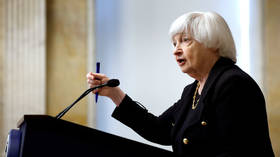US stocks crash after bond market flashes strong recession warning
US markets opened in the red on Wednesday, with the Dow Jones Industrial Average losing more than 400 points, after the US bond market sparked new fears about a looming recession.
After Tuesday’s gains on the decision to postpone tariffs on Chinese imports, US stocks saw another huge selloff. The Dow was down around 1.5 percent, while S&P 500 fell 1.4 percent to 2.885.42 points. The Nasdaq Composite dropped 1.55 percent to 1.892.23 points after the opening bell.
Also on rt.com ‘Flashing yellow’: US facing 1 in 3 chance of recession within the year, says Bank of AmericaBank stocks, including Wall Street titans JP Morgan Chase and Bank of America, led Wednesday’s selloff. Shares of Bank of America were trading down 2.75 percent, while JP Morgan also dropped nearly 2.5 percent.
The sharp decline occurred after the yield on the benchmark 10-year Treasury note dipped below the 2-year rate on Wednesday. Such a situation is called a yield curve inversion, which is a strong indicator for economic recessions. A similar picture preceded every recession over the past 50 years.
As of 2019-08-12 at 5:00PM ESTTwo Year Yield: 1.58Ten Year Yield: 1.65Spread: 0.07, down 0.09 from last week (0.16) pic.twitter.com/C2xFoWY9fw
— Yield Curve Inversion Watch (@YieldCurveWatch) August 13, 2019
Ahead of the last recession, the yield curve inverted briefly in December 2005, about two years before the financial crisis hit.
“The equity market is on borrowed time after the yield curve inverts,” Bank of America Merrill Lynch analysts wrote on Tuesday.
An inverted yield curve is usually accompanied by other “ominous economic signals” such as layoffs and credit deterioration, according to Jonathan Golub, chief US equity strategist at Credit Suisse. When the phenomenon finally occurs, equity markets usually have 18 months of gains, and about 22 months before the start of the recession, the bank says.
For more stories on economy & finance visit RT's business section













